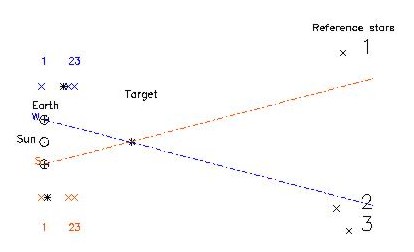
 |
Determing Parallaxes
Since stars are at an immense distance we need a much larger baseline than the distance between our two eyes and to achieve this we use the orbit of the Earth. Consider a nearby star labelled as Target in this diagram of the earth-sun-target-reference star arrangement (with an extremly exhaggerated scale). During the winter the target appears in the relative position colored blue during the summer that colored red. Over the course of the year the target traces out an ellipse that is the mirror image of the orbit of the Earth distorted by the position of the target with relation to the plane of the orbit of the Earth.
Here are two examples of how a star would move if it's position was perpendicular to the orbital plane of the Earth and if it's position was close to the plane of the Earth. The arrow represents another motion that we see which is intrinsic to the target. Combined with the mirror image of the earth's motion we obtain spiral or wave patterns, to see this let us look at some real data.
Here we see observations of the star LHS2632 over 5 years, as you can see the motion is a wave/spiral pattern as discussed. The scales are angular motion in arcseconds, if you consider that on a typical night stars will subtend 2 arcseconds the whole of the motion - parallactic and intrinsic - over 5 years are less than the typical size of a star. The measurement of this tiny shift requires very precise instrumentation that is stable for periods of at least 4 years. The combination of the 1.05m telescope and a fixed CCD provides that kind of precision and stability, indeed the precision of the OATo configuration allows a measurement of 1000th of an arcsecond in the final parallax.
Other sites that describe the physics of parallax and it's determinations are this java simulation and this astronomy lab. |
|
INAF OATO - Strada Osservatorio 20 - 10022 Pino Torinese (TO) | | contacts | web solution: effetti |




